|
|
| 'Like' us on Facebook | Follow us: |
Posted on: Mar 04, 2016
THE PERSONA OF SHIVA
The Telling Messages Encoded in His Enigmatic Form
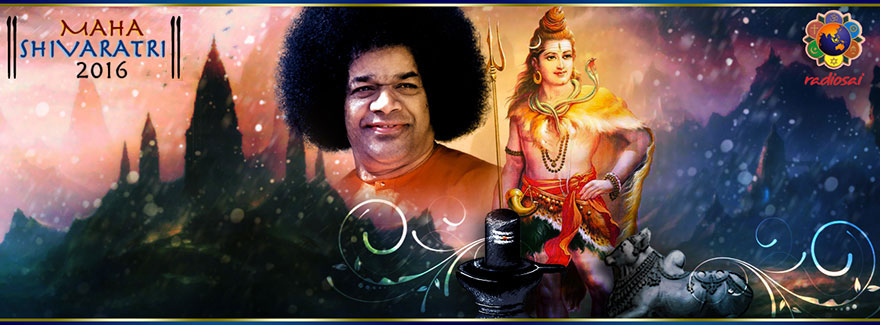 |
In January 2016 on Radio Sai we started an audio series “Saints – the Soul of India”. The first episode was on Saint Andal, the transcript of which was published. Later we had another episode on Saint Andal's immortal work Tiruppavai, followed by Saint Tyagaraja's masterpiece musical composition - The Pancharatnas. The fourth episode which was played as part of Thursday Live programme on March 3, 2016 was on Saint Manikkavasagar. This discussion is actually in four parts. However a major portion of the first part was a deliberation on Shivaratri and the Shiva Principle. Presented below are the highlights of this conversation between Radio Sai's Bishu Prusty (BP) and a Radio Sai volunteer Mrs. Lalitha Shekhar (LS).
BP: Sairam Mrs. Lalitha Shekhar. Did you notice that this year (2016) Shivaratri falls on a Monday or Somavara as it is called in many Indian languages?
LS: Oh yes, the day of the week earmarked for the worship of Shiva.
BP: In fact, Bhagawan Himself was born on a Somavara in the Indian month of Kartika. In the auspicious early hours of that morning, when the entire village of Puttaparthi was immersed in chanting hymns in praise of Shiva, Lord Sai Shiva decided to descend. The significance of the timing of this event became clearer and more pronounced when in 1963 Bhagawan made the historic announcement “I am Shiva Shakti. No wonder, Shivaratri has been such an important celebration in Puttaparthi right from the 1940s.
The Mind-Moon Connection
LS: The Lingodbhavam spectacle undoubtedly made Shivaratri a historic event. Along with this, the message that Swami gave on this occasion every year was too profound and pertinent. For example, you mentioned about Somavara. Soma means moon and the festival of Shivaratri is connected to the moon. Well, how can it be not connected to the moon when Shiva adorns Himself with the moon!
Shivaratri literally means ‘the night of Shiva’. Bhagawan says that unlike any other night, this is the night of concentration, dedication and illumination. We know every month is divided into two fortnights. Shivaratri falls on the fourteenth day after the full moon day – the time when the moon is least visible. The moon loses one-sixteenth of its brilliance every day and so on the fourteenth day it has only one-sixteenth of its power. This is significant because the moon is related to the mind. The scriptures declare chandrama manaso jataha (the moon has emerged from the mind). Since the moon is so subdued during this period, Bhagawan says it is that much easy to control the waywardness of the mind; it can be swiftly achieved with sadhana (spiritual effort).
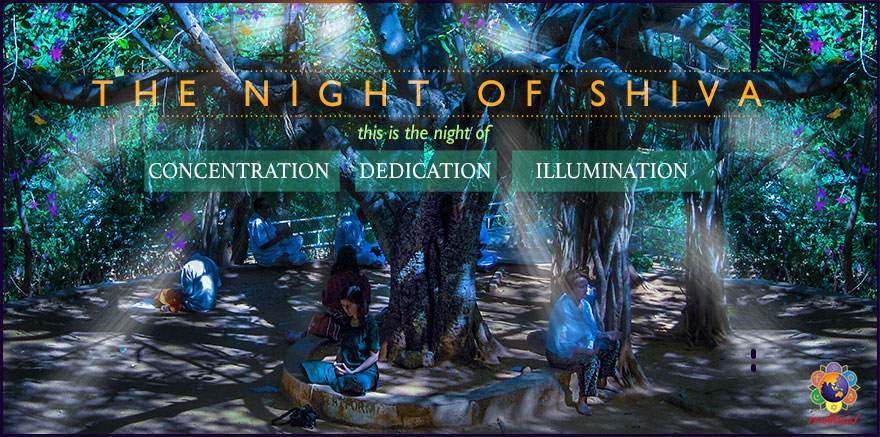 |
This effort can be in many ways, one of them being keeping vigil all night and chanting His name. That is why we do akhanda bhajans, the non-stop bhajan singing.
BP: That is very symbolic of how this effort should be a continuous exercise all our life, isn't it?
LS: Correct. People also fast during this period. This again is symbolic. In reality, it is divesting the senses of the pleasures they crave for; in simple terms, as Swami says, it is putting a ceiling on our desires and diverting them to God.
BP: But doesn't this night come every month?
LS: You are right, it does. It is called Masa Shivaratri, that is, it happens when the moon wanes every month. However the one that occurs in the Indian month of Magha is considered most auspicious. That is why it is called ‘Maha Shivaratri’.
BP: It is the most propitious time to melt into Shiva, I guess. Every Maha Shivaratri morning when those hymns are chanted you just feel so sublimated. Effortlessly they elevate you. Actually if one just says to oneself ‘Shivoham Shivoham Shivoham’, this itself quietens your being. When your mind concentrates on that form it automatically calms down.
The Enchanting and Enigmatic Form of Shiva
I remember in 2003 Bhagawan in His Shivaratri discourse gave a beautiful description of Lord Shiva:
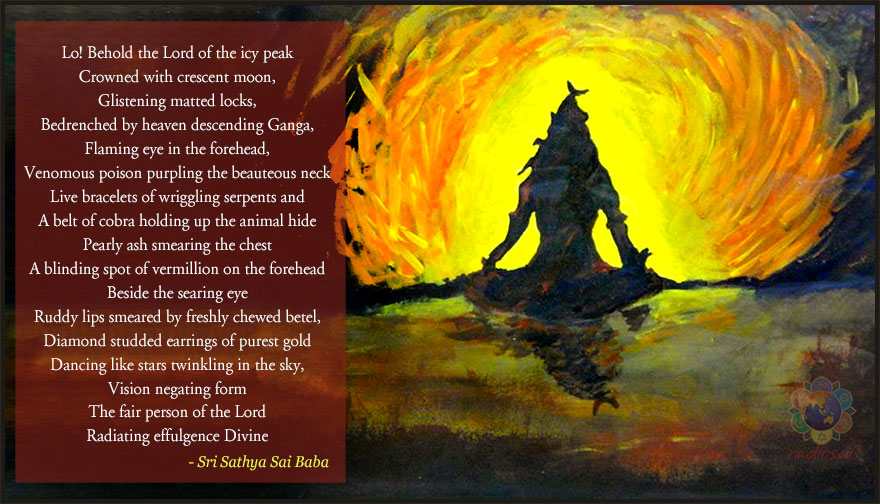 |
LS: Amazing! This is one instance when we got to listen to Parameshwara describe Himself. In fact Shiva's form is so unique. He is called as ‘Adi Yogi’, the foremost among yogis. This is the form of Shiva that most often comes to our mind – the serene Lord with His eyes half-closed, lost in deep meditation. The moment He surfaces in your mind you are in peace. There is so much beauty in His serenity and simplicity.
In fact this form is so enchanting that many saints and sages have sprung forth with splendid compositions on the glory of this vision. And this is not restricted to Shaivite saints alone. Sri Chaitanya Mahaprabhu, the great saint from Bengal who was always immersed in Krishna consciousness, too came up with a Shivashtakam – eight stanzas just describing this mesmerising form. Some of them go like this:
Salutations and salutations to Him
Who has moon, sun and fire as His eyes,
Who is the universal Shiva who dispels darkness
And who by His thousand beamed power,
Defeats thousands of moons and suns.
Salutations and salutations to Him,
Whose form shines like the gem
On the head of the king of snakes
Who wears the skin of tiger
Who has an effulgent form
Who stands amidst a lotus
With one thousand petals
And who wears lustrous amulets
On His two hands
Sri Chaitanya said that you can attain Hari by fixing your mind on Hara (Shiva). In fact this takes my mind to the blissful Shivaratri mornings of Prasanthi Nilayam when these hymns used to be chanted and Swami would be sitting there, lost in bliss. How ethereal it used to be! Truly, every student and devotee present on these occasions was being blessed with the darshan of Hari and Hara.
Sai Shiva in Kaliyuga Kailasha
BP: Absolutely! I am really tempted to relive those timeless moments. Sages and saints of the past visualised Shiva in their mind's eye but the students and devotees of this era physically saw Him, seated right in front of them and blissfully listening to the chanting of Lingashtakam, Bilvashtakam, Vishwanathashtakam and so on.
I remember on Shivaratri mornings, Swami would emerge adorned in yellow or sometimes in white, and after the darshan round He would take His place at the centre of the stage. Then the chanting would begin and He would soon close His eyes. For a little while His hand would be moving gently in the air but that too would soon stop. He would become still. Completely still.
LS: Then your minds too become still.
BP: So true! Bhagawan says “When I am with men I am a man, with women I am a woman, with children I am a child, and when I am alone I am God.” To me, those were the ‘God moments’. He is that 'Being Awareness Bliss Atman'. The serenity of those moments would just transport you to Kailasha. In fact Prasanthi Nilayam is transformed into Kailasha and you are sitting at the feet of Shiva Sai!
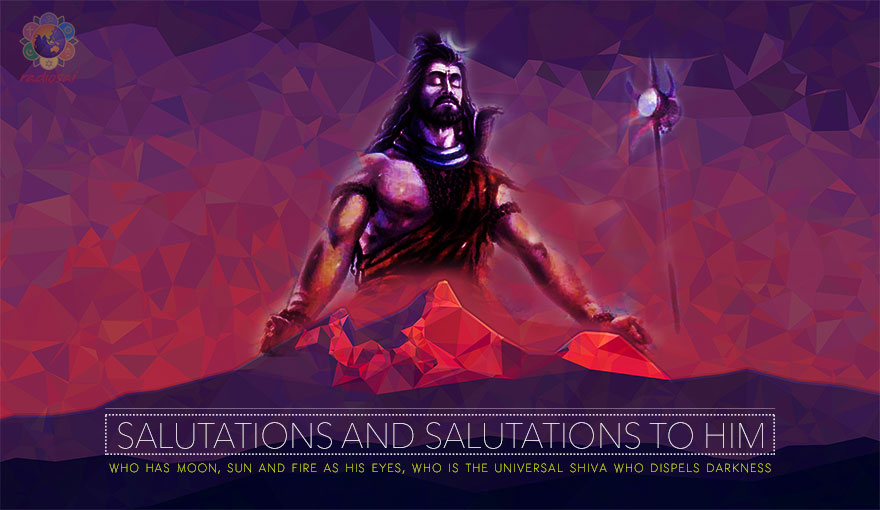 |
You never wanted that scene to ever end. You did not want the chanting to cease. You never wanted anything of that moment to change. It just filled you with so much peace.
LS: These chants are so powerful that wherever you may be, at home or outside, the moment you hear them you feel lighter and better; they take you to a different dimension. Now imagine listening to them with Swami sitting right in front of you!
BP: The beauty of Shivaratri, as you mentioned before, is that you have these chants in the morning which describe the most beautiful and the seemingly unreal form of Shiva, what with the moon on His head, river Ganga falling from His locks and so on.
And in the evenings you had Bhagawan explain the significance of the various aspects of this mysterious form.
The Latent Lessons in the Potent Form
LS: In fact I am reminded of a beautiful hymn from the Abhinaya Darpanam (the scripture on dance) which says:
āngikam bhuvanam yasya
vācikam sarva vāngmayam
āhāryam candra tārādi
tam vandē sātvikam śivam
We bow down to Lord Shiva
Who is full of purity and auspiciousness
Whose body is this world,
Whose speech is the universal language, and
Whose ornaments are the moons and the stars.
Bhagawan says the third eye of Shiva represents gnana, the eye of cosmic knowledge. He can grant the knowledge of all the three paths to attain Him, that is, Karma, Bhakti and Gnana (work, worship and wisdom). He can bestow that in a split second. The three eyes also connote that He is the Master of the Past, Present and the Future. In fact He is the One who controls time as well as transcends time.
Similarly, His weapon of trident is symbolic of how He can eliminate all the three gunas – Satva, Rajas and Tamas – in us. One can attain the Lord only when one rises above these characteristics. The Supreme Lord is Gunateetha and Nirguna – He is beyond these attributes, and Shiva with His trident helps us to reach that state.
BP: In the ultimate analysis, even the Satva guna, the good traits, has to be transcended. I guess the presence of any attribute leads to building up of karma.
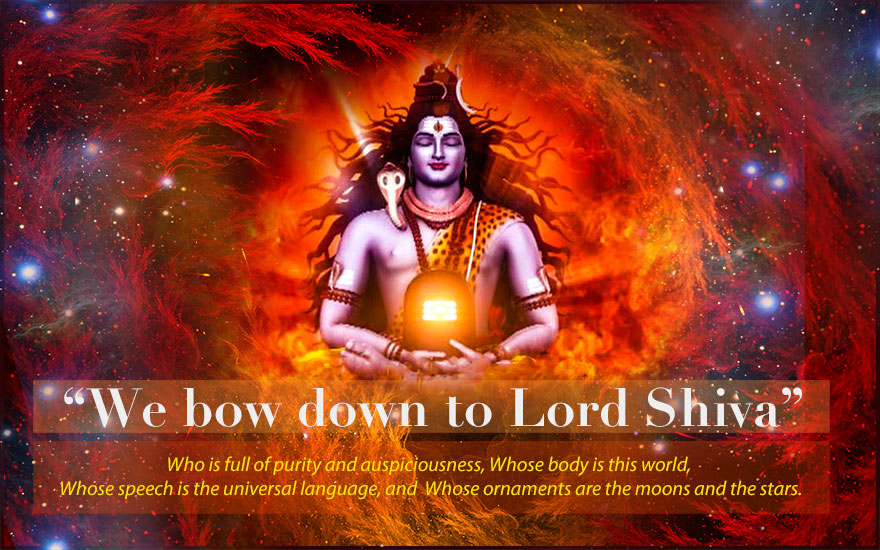 |
LS: Yes, one has to become empty. His ash-smeared body gives such a message. He is teaching us that everything is temporary. Whatever we think is permanent is one day going to be reduced to nothing; ash is the inevitable end of everything.
The mention of tiger brings to our mind an image of ferociousness, fearlessness and strength. But Shiva wears a tiger skin, which demonstrates how even the most feared force is completely conquered by Him.
BP: That is why He is ‘Pashupati’.
LS: Yes, the One who has conquered all the animal tendencies. The lesson that Nandi, the bull of Shiva, teaches is tremendous. The bull is completely tamed and timid in His presence; its undivided attention is only on Lord Shiva.
I had recently been to the temple of Arunachaleshwara in Tiruvannamalai in Tamil Nadu. Interestingly, this temple unusually has three Nandis. The one at the entrance of the temple is really huge in size, the next one which is midway to the shrine is much smaller, and the one right in front of the Lingam is the smallest. To me this was an elaboration on how one's bestial tendencies diminish gradually as you go closer to the Lord; they are at their lowest when the Lord is closest.
BP: Beautiful! It is like the moon waning.
LS: Exactly. When you march towards the Lord, He helps us conquer the most difficult of our tendencies. We only have to take that step and willingly offer ourselves to Him.
BP: The other beautiful aspect of Nandi is how just by having that one-pointed focus on the Lord, it rose to become His messenger. It is a common practice for devotees in Shiva temples to whisper their wishes into the ears of the Nandi. It is believed that one's prayers reach the Lord directly if it is channelled through the Nandi; it is fool-proof. From being a beast to becoming a beautiful carrier of the Lord – Nandi achieved this blessing only through its unwavering, undisturbed and undivided attention on the Lord.
 |
LS: There is also another practice. As a child when I used to go Shiva temples, I remember my mother asking me to look at the Shiva Lingam from in between both the horns of the Nandi. That way you cannot see anything else. You will automatically directly see the Lord. This is because the Nandi's eyes are always fixed on His Master. I feel the Nandi is showing us how a servant and a devotee of the Lord should be.
BP: What a powerful lesson, that too from a beast!
LS: Yes. When we reflect on each aspect of the Lord's form on these lines it is so uplifting. Now when we chant the hymns dedicated to Lord Shiva with this understanding, the entire experience is so sanctifying and sublimating.
BP: Absolutely. When I sing these shlokas and envision Shiva, to me His form is a very cryptic and comprehensive elaboration of creation itself. For example, everything around us is a play of opposites. Positive and negative, day and night, birth of a flower and death of a creeper, cold in the morning and warm in the afternoon, and so on. As they say the universe is full of yin and yang. That exactly is what is Shiva and Shakti, or as Bhagawan has explained, the play of Purusha (Creator) and Prakriti (Nature).
In one discourse Swami said that Pranava or Om has within it both the powers of Shiva and Shakti. The scientists refer to this as electrons and protons, the two constituents of the atom. This is actually Shiva and Shakti inextricably associated with each other.
If you reflect on the form of Shiva, He is such a beautiful conglomeration of both these forces. You see in Him the best of positivity and the heights of negativity. For instance, you have the cool river Ganga flowing out of His head but right at the forehead is His third eye which is nothing but fire. Again, water which is symbolic of the birth of life comes out of His hair but His body is smeared with ashes which connotes the end of everything.
Thinking on the same lines, His matted hair and His tiger-skin attire make Him look like a perfect ascetic but at the same time there is Shakti next to Him.
LS: She is not only next to Him but He has in fact given half of Himself to her.
BP: True, Shiva would do anything for Shakti because of the love that Shakti has for Him. In fact the story of how Shakti attained Shiva is such a profound tale – it is essentially the journey of every Jivatma to the Paramatma. It is only because of her unparalleled purity and unimaginable penance and penitence that the merciful Lord gave away half of Himself to her.
So, you see Shiva as an exalted renunciant as well as an ideal householder. He has a family whom He loves so much.
'Unity in Diversity' in Shiva's Family
LS: Undoubtedly. And His family interestingly is again full of opposites. He has a snake around His neck but His son Ganesha has a rat which a snake cannot resist. Similarly His other son Subrahmanya has a peacock and we know how serpents and peacocks are sworn enemies. Shakti rides on a lion and that is why she is Simha Vahini but Ganesha has the head of an elephant. It is said if an elephant even dreams of a lion it goes mad. Not only that, here Shakti's lion and Shiva's bull are happily sitting together!
If you look at Shakti, she is bedecked with gold and the finest of jewellery but Shiva is adorned with the simplest of ornaments – the Rudraksha beads. In fact Shiva is called as Digambara because all He uses to cover Himself is a tiger skin.
Like this even though everything seems so contradictory in Shiva's family, what you see is a tightly-knit unit where each one is there for the other and all are there at the feet of Shiva-Shakti with great happiness and love.
 |
BP: Such a relevant lesson for all of us! Even though it is a divinely-ordained family still it is so full of opposites. I guess we should not complain if some people in our family have divergent views and wavelengths. This is how it is meant to be. Our strengths actually lie in that variety just like the hand does a million things because the size, shape and character of each finger are different from the other.
LS: In fact that is how everything in Nature is. How boring my life would have been if all my kids were of exactly the same size, temperament and talent. There would be no challenge or learning.
BP: The world would have been a boring place. But the Lord always wants vibrancy, colour and activity just like how His Tandava dance is.
In fact Shiva's form is so fascinating and so meaningful that there is no end to the learning He imparts. The more you dwell on Him the more you are stupefied.
On His throat Shiva carries poison which stops life while from His head flows water, which creates life. One of the main objectives of man's space explorations has been to find out if there is life anywhere else, and the way to ascertain this is to check for signs of water.
The other amazing aspect of this enigmatic form is on Him you see the most dangerous of creatures like the serpent and the lion and also the gentlest beings from the animal kingdom like the peacock and the bull. You have grass being offered to Ganesha and Bilva leaves used to worship Shiva. Shakti has the lotus on her hands.
Shiva's army consists of the ganas who are celestial beings while His own son is half-man and half-elephant. So you have representation from flora, fauna, humankind, heavenly beings, and even from space with the moon resting on His head. So, to me it is an amazing imagery of the creator and His creation so beautifully packed in this incredulous form.
Attaining the Impenetrable Shiva
LS: We can never understand Him and it is futile to even think of attempting to do this. Personally, from the time I have known Swami, I thought if I try to understand Him I will lose a lot of time. Therefore the best thing to do is love Him; then maybe He will give me enough wisdom to know what I need to do to reach Him. In any case, that is the ultimate goal.
BP: So true. That is why the Vedas have described Him as timeless, placeless, birthless, deathless, decayless, and so on. He is neither night nor darkness. Neither form nor energy. Neither sound nor matter. He is in fact dwandwateeta – the One who is beyond the pairs of opposites.
LS: Right. The Vedas say māyām tu prakṛtim viddhi māyinam tu maheśvaram, that is, know Prakriti to be maya and Maheshwara to be the wielder of maya.
However, this inscrutable Lord is actually not intensely difficult to attain. There is one way by which anyone can bind him and that is Love. Love indeed is the most powerful vibration of this universe. Even the Lord cannot resist the power and pull of pure love.
BP: This indeed is the path taken by so many saints. They bound the Lord with their sincere and steadfast love. Through the intensity of their love they not only attained wisdom but also the fruit of all wisdom.
LS: Absolutely. The Lord is indeed easy to please. Simple acts of love delight Him. He does not ask or look for elaborate rituals. In every Shiva temple one would find a copper pot with a hole in the centre from which water ceaselessly falls on to the Shiva Lingam. Just this simple abhishekam with water is enough as a ritual. The Lord is appeased and He is ready to shower boons. That is why He is called Bholenath. ‘Bhola’ means an innocent one who can easily be manoeuvred.
BP: Our scriptures are full of stories of so many who received incredible boons from Shiva. Even Ravana had got all his powers with his worship of Lord Shiva.
LS: Yes, He will grant the wishes of anyone who remembers and pines for Him with sincerity. In Tamil Nadu, there are stories of 63 Shaivite saints who are called Nayanmars. In fact in any famous Shiva shrine one would find images of these saints. In the Arunachala temple, for example, all these great devotees can be seen in the sanctum sanctorum area. As people circumambulate the Linga, their eyes fall on all these spectacular souls. The great poet-saint Sekkizhar compiled the life stories of all these enlightened devotees and called this volume ‘Periya Puranam’.
Indeed reading a copy of ‘Periya Puranam’ is what spurred the little boy Venkataraman to come to Tiruvannamalai and eventually transform into Bhagawan Ramana Maharshi. That is how powerful these tales are.
 |
| Download the wallpaper |
BP: No wonder Swami always advised the students to study the lives of saints. Ruminating on their lives clears our doubts, cleans our heart and carries us to our goals. Saints like Manikkavasagar, Kannappa and Sambandar have inspired generations to cultivate rock-like faith and experience nectar-like grace. In a nutshell, what they taught us and continue to tell us is: Love God with all your heart, strength, mind and soul, and the Lord will bestow on you His heart, His strength and even His soul, and much more.
Swami concluded the 2003 Shivaratri discourse saying:
“If you wish to attain happiness, live in happiness. The universal family of Lord Shiva, Mother Parvati, Subrahmanya, and Vinayaka is the perfect example for this principle. Emulate them. Worship them. But a caution: you may worship a picture as God but not God as a picture. Therefore, worship the Easwara family by following their example. The message of Shivaratri is to live in unity and harmony with everyone.
“Lead a life of character and good behaviour. That is the only thing I want. That is the only thing that gives me joy. Not only the students but the devotees must also ensure good behaviour. They must feel that they are the members of the universal family of Lord Shiva. Mother Parvati constitutes the body, whereas Lord Shiva represents the heart. When the body and heart join together as a dwelling, human nature resides there. This is called Prakriti. The human body represents Pravritti, whereas the Atma residing in the body represents Nivritti. The unity of this Pravritti and Nivritti is human nature. Having been born in such a sacred human nature, people are forgetting their innate divinity.
“Shed your ego and cultivate pure and selfless love towards one and all. There is nothing in this world that cannot be achieved with love.”
LS: Let us fill our Shivaratris with this purity of Shiva and experience the love and bliss of Sai.
- Radio Sai Team
What do you think about this article? Please let us know by writing in to h2h@radiosai.org or you may leave your thoughts in the comments section. Do not forget to mention your name and country.
| comments powered by Disqus |






